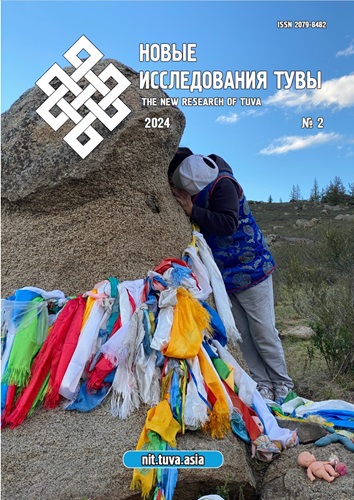Interaction of indigenous minority peoples: resilience and sustainable development of remote and hard-to-reach territories
DOI:
https://doi.org/10.25178/nit.2024.2.16Keywords:
indigenous peoples; Tuva; Buryatia; Yakutia; Amur region; Irkutsk region; remote territory; hard-to-reach territory; network analysis; sustainable developmentAbstract
The article examines the territorial relations of the Tuvan-Todzhin residents of Todzhinsky Kozhuun in the Republic of Tuva, the Soyots of Okinsky District in the Republic of Buryatia, the Tofalars of Nizhneudinsky District in the Irkutsk Region, the Evenks of Tyndinsky District in the Amur Region, and the Neryungrinsky District in the Sakha Republic (Yakutia). These areas are home to indigenous minority groups from different regions of Russia, who live in remote and hard-to-access territories. The research aims to find the optimal set of indicators for sustainable development at the local level for indigenous communities that preserve traditional forms of environmental management. The authors believe that this can be achieved through the application of a meta-disciplinary approach, using ontologies, models, and indicators to show the consistency of economic, ecological, ethnocultural, and social aspects.
Three types of social connections are identified in the topological field: family (kinship) relationships, cultural interaction, and economic activity. Traditional life support is also considered. The main conclusion is the stratification and detailed analysis of connections between residents based on the type and scale of their interactions.
References
Bezrukov, L. A. and Dashpilov, Ts. B. (2010) Transport-geographical position of microregions of Siberia: methodology and assessment results. Geografiia i prirodnye resursy, no. 4, pp. 5–13. (In Russ.).
Vainshtein, S. I. (1961) Tuvans are Todzhin people. Historical and ethnographic essays. Moscow, Nauka. 218 p. (In Russ.).
Vasilevich, G. M. (1950) On the collective farms of the Dzhugdyr Evenks. Izvestiia Vsesoiuznogo geograficheskogo obshchestva, vol. 82, no. 2, pp. 163–173. (In Russ.).
Vasilevich, G. M. (1969) Evenki: historical and ethnographic essays: (XVIII — early XX century). Leningrad, Nauka, Leningradskoe otdelenie. 304 p. (In Russ.).
Dugarov, B. S. (1983) About the origin of the Okinsky Buryats. In: Ethnic and historical-cultural ties of the Mongolian peoples: a collection of articles / ed. by T. M. Mikhailov. Ulan-Ude, BF SO AN SSSR. 147 p. Pp. 90–101. (In Russ.).
Kalikhman, T. P. and Kalikhman, A. D. (2011) Sayan Crossroads as a cross-border object of the World Natural and Cultural heritage. Izvestiia Russkogo geograficheskogo obshchestva, vol. 143, no. 1, pp. 72–81. (In Russ.).
Kalikhman, A. D. and Kalikhman, T. P. (2020) Conceptual and paradigmatic foundations of regional studies. In: IV Gotlib Readings: Oriental Studies and Regional Studies of the Asia-Pacific region in the context of transdisciplinary knowledge: proceedings of an International Scientific Conference. Irkutsk, December 7–9, 2020 / ed. by E. F. Serebrennikova. Irkutsk, IGU Publ. 487 p. Pp. 266–284. (In Russ.).
Kuzeev, R. G. and Babenko, V. Ya. (1992) Ethnographic and ethnic groups (On the problem of ethnos heterogeneity). In: The ethnic group and its divisions: in 2 parts / ed. by R. G. Kuzeev and V. A. Tishkov. Moscow, Institut etnologii i antropologii im. N. N. Miklukho-Maklaia RAN. Part 1. Ethnic and ethnographic groups. 172 p. Pp. 17–38. (In Russ.).
Kuklina, V. V. and Filippova, V. V. (2019) Transport accessibility and the way of life of the population in the north: a case study of the Sakha (Yakutia) Republic. Geography and Natural Resources, no. 2, pp. 132–140. (In Russ.).
Lamazhaa, Ch. K. (2017) Sub-ethnic groups of the Tuvans: problems of definition and research. New Research of Tuva, no. 1, pp. 4–21. (In Russ.). DOI: https://doi.org/10.25178/nit.2017.1.1
Mongush, M. V. (2012) Tofalars and soyots. Historical and ethnographic essay. New Research of Tuva, no. 2, pp. 62–78. (In Russ.).
Mutovin, S. I. and Sud'in, K. N. (2014) Tools for sustainable development of the Northern Territories: the experience of regional studies. Krasnoiarsk, Sibirskii federal'nyi universitet. 132 p. (In Russ.).
Petri, B. D. (1927) Ethnographic research among small peoples in the Eastern Sayans (Preliminary data). Irkutsk, Tip. izd-va «Vlast' truda». 21 p. (In Russ.).
Rassadin, V. I. (1971) Phonetics and vocabulary of the Tofalar language. Ulan-Ude, Buriatskoe knizhnoe izdatel'stvo. 251 p. (In Russ.).
Turkic peoples of Eastern Siberia (2008) / ed. by D. A. Funk and N. A. Alekseev. Moscow, Nauka. 422 p. (In Russ.).
Trufanov, A. I., Tukhvatullina, A. F., Lyzin, I. A. and Taranik, M. A. (2018) Creation of a single set of effective tools for time series network analysis. In: Information technologies in science, management, social sphere and medicine: collection of scientific papers of the V International Scientific Conference: in 2 parts. Tomsk, Natsional'nyi issledovatel'skii Tomskii politekhnicheskii universitet. Part 2 / ed. by O. G. Berestneva et al. 487 p. Pp. 323–327. (In Russ.).
Tugolukov, V. A. (2013) The Evenks of Eastern Siberia and the Far East. Krasnoiarsk, Sibirskie promysly. 335 p. (In Russ.).
Filippova, V. V. (2020) Access to the Territories of Traditional Natural Resource Management: Mobility of Local Communities in the Conditions of Industrial Development. Kunstkamera, no. 1 (7), pp. 36–42. (In Russ.). DOI: https://doi.org/10.31250/2618-8619-2020-1(7)-36-42
Filippova, V. V., Savvinova, A. N., Fondal, G. (2020) Evenki of River Basin Olyokma: Resettlement and Land Use in the XXI Century. Nauchnyi dialog, no. 1, pp. 495–509. (In Russ.). DOI: https://doi.org/10.24224/2227-1295-2020-1-495-509
Barabási, A.-L. and Albert, R. (1999) Emergence of scaling in random networks. Science, vol. 286, issue 5439, pp. 509–512. DOI: https://doi.org/10.1126/science.286.5439.509
Berestneva, O. G., Tikhomirov, A. A., Trufanov, A. I., Kuklina, M. V., Kobylkin, D. V., Krasnoshtanova, N. E., Bogdanov, V. N., Istomina, E. A., Batotsyrenov, E. A., Dirin, D. A., Savvinova, A. N., Filippova, V. V., Altangerel, E. and Dashdorj, Z. (2023) Network metrics in sustainable development of remote territories. In: System analysis in design and management: collection of scientific papers of the XXVI International Scientific and Practical Conference: in 3 parts / ed. by G. P. Chudov and A.V. Loginov. St. Petersburg, Sankt-Peterburgskii politekhnicheskii universitet Petra Velikogo. Part. 3. 468 p. Pp. 183–195. DOI: https://doi.org/10.18720/SPBPU/2/id23-475
Bródka, P. and Kazienko, P. (2018) Multilayer Social Networks. In: Alhajj, R., Rokne, J. (eds) Encyclopedia of Social Network Analysis and Mining. Springer, New York, NY. LXXIII, 3431 p. P. 1408–1422. DOI: https://doi.org/10.1007/978-1-4939-7131-2_239
Byakagaba, P., Mugagga, F. and Nnakayima, D. (2019) The socio-economic and environmental implications of oil and gas exploration: Perspectives at the micro level in the Albertine region of Uganda. The Extractive Industries and Society, vol. 6, no. 2, pp. 358–366. DOI: https://doi.org/10.1016/j.exis.2019.01.006
Dickison, M., Magnani, M. and Rossi, L. (2016) Moving Out of Flatland. Multilayer Social Networks / ed. by Dickison M., Magnani M., Rossi L. Cambridge: Cambridge University Press. 79 p. P. 1–12. DOI: https://doi.org/10.1017/CBO9781139941907.001
Dragić, N., Keynan, O. and Ilany, A. (2021) Multilayer social networks reveal the social complexity of a cooperatively breeding bird. iScience, vol. 24, issue 11: 103336. DOI: https://doi.org/10.1016/j.isci.2021.103336
Dunbar, R. (2018) The Anatomy of Friendship. Trends in cognitive sciences, vol. 22, issue 1, pp. 32–51. DOI: https://doi.org/10.1016/j.tics.2017.10.004
Erikson, E. (2018) Relationalism and Social Networks. In: Dépelteau, F. (eds) The Palgrave Handbook of Relational Sociology. Palgrave Macmillan Cham. XXI, 686 p. P. 271–287. DOI : https://doi.org/10.1007/978-3-319-66005-9_13
Friemel, T. N. (2011) Dynamics of Social Networks. Procedia — Social and Behavioral Sciences, vol. 22, pp. 2–3. DOI: https://doi.org/10.1016/j.sbspro.2011.07.050
Gates, A. J., Ke, Q., Varol, O. and Barabasi, A.-L. (2019) Nature’s reach: narrow work has broad impact. Nature, vol. 575 (7781), pp. 32–34. DOI: https://doi.org/10.1038/d41586-019-03308-7
Ghoshal, G., Mangioni, G., Menezes, R. and Poncela-Casanovas, J. (2014) Social system as complex networks. Social Network Analysis and Mining, no. 4: 238. DOI: https://doi.org/10.1007/s13278-014-0238-9
Goryashko, A., Samokhine, L. and Bocharov, P. (2019) About complexity of complex networks. Applied Network Science, issue 4: 87. https://doi.org/10.1007/s41109-019-0217-1
Guimerà, R. and Sales-Pardo, M. (2009) Missing and spurious interactions and the reconstruction of complex networks. Proceedings of the National Academy of Sciences / ed. by H. Eu. Stanley. Boston, MA: Boston University. Vol. 106, no. 53, pp. 22073–22078. DOI: https://doi.org/10.1073/pnas.0908366106
Han, Q., Wen, H. and Miao, F. (2018) Rumor spreading in interdependent social networks. Peer-to-Peer Networking and Applications, vol. 11, pp. 955–965. DOI: https://doi.org/10.1007/s12083-017-0616-y
Hoppler, S., Segerer, R. and Nikitin, J. (2022) The Six Components of Social Interactions: Actor, Partner, Relation, Activities, Context, and Evaluation. Frontiers in Psychology, vol. 12: 743074. DOI: https://doi.org/10.3389/fpsyg.2021.743074
Kleinberg, J. (2008) The convergence of social and technological networks. Communications of the ACM, vol. 51, no. 11, pp. 66–72. DOI: https://doi.org/10.1145/1400214.1400232
Konstantinov, Y. (2009) Roadlessness and the person: mode of travel in the reindeer herding part of the Kola Peninsula. Acta Borealia, vol. 26, issue 1, pp. 27–49. DOI: https://doi.org/10.1080/08003830902951524
Krasnoshtanova, N. (2023) Sustainability of Local Communities in a New Oil and Gas Region: The Case of Eastern Siberia. Sustainability, vol. 15, issue 2: 9293. DOI: https://doi.org/10.3390/su15129293
Kuklina, M., Dirin, D., Filippova, V., Savvinova, A., Trufanov, A., Krasnoshtanova, N., Bogdanov, V., Kobylkin, D., Fedorova, A. and Itegelova, A. (2022) Transport Accessibility and Tourism Development Prospects of Indigenous Communities of Siberia. Sustainability, vol. 14, issue 3: 1750. DOI: https://doi.org/10.3390/su14031750
Landi, P., Minoarivelo, H. O., Brännström, Å., Hui, C. and Dieckmann, U. (2018) Complexity and stability of ecological networks: a review of the theory. Population Ecology, vol. 60, issue 4, pp. 319–345. DOI: https://doi.org/10.1007/s10144-018-0628-3
Lev-Ari, S., Haidari, B., Sayer, T., Au, V. and Nazihah, F. (2021) Noticing how our social networks are interconnected can influence language change. Language, Cognition and Neuroscience, vol. 36, issue 1, pp. 119–134. DOI: https://doi.org/10.1080/23273798.2020.1820056
Lordan, O. and Sallan, J. M. (2020) Dynamic measures for transportation networks. PloS one. №, no. 15 (12): e0242875. DOI: https://doi.org/10.1371/journal.pone.0242875
Mehra, A., Marineau, J., Lopes, A. and Dass, T. (2009) The coevolution of friendship and leadership networks in small groups. In: Predator's game-changing designs: Research-based tools / ed. by Graen G. B., Graen J. A., IAP. 247 p. Pp. 145–162.
Omodei, E., De Domenico, M. and Arenas, A. (2017) Evaluating the impact of interdisciplinary research: A multilayer network approach. Network Science, vol. 5, issue 2, pp. 235–246. DOI: https://doi.org/10.1017/nws.2016.15
Oselio, B., Liu, S. and Hero, A. (2018) Multilayer Social Networks. In: Cooperative and Graph Signal Processing. Ed. by P. Djuric and C. Richard. Academic Press. 866 p. Pp. 679–697. DOI: https://doi.org/10.1016/b978-0-12-813677-5.00025-0
Rinzin, C., Vermeulen, W. J. V. and Glasbergen, P. (2007) Public perceptions of Bhutan’s approach to sustainable development in practice. Sustainable Development, vol. 15, pp. 52–68. DOI: https://doi.org/10.1002/sd.293
Schwartz, G. A. (2021) Complex networks reveal emergent interdisciplinary knowledge in Wikipedia. Humanities and social sciences communications, vol. 8: 127. DOI: https://doi.org/10.1057/s41599-021-00801-1
Schweitzer, P., Povoroznyuk, O. and Schiesser, S. (2017) Beyond wilderness: towards an anthropology of infrastructure and the built environment in the Russian North. The Polar Journal, no. 7 (1), pp. 58–85. DOI: https://doi.org/10.1080/2154896X.2017.1334427
Sinha, S., Bhattacharya, R. N. and Banerjee, R. (2007) Surface iron ore mining in eastern India and local level sustainability. Resources Policy, vol. 32, issue 1–2, pp. 57–68. DOI: https://doi.org/10.1016/j.resourpol.2007.06.001
Storey, K. (2010) Fly-in/Fly-out: Implications for Community Sustainability. Sustainability, no. 2, pp. 1161–1181. DOI: https://doi.org/10.3390/su2051161
Weijnen, M. P., Herder, P. M. and Bouwmans, I. (2008) Designing Complex Systems A Contradiction in Terms. Proceedings of Delft Science in Design, A Congress on Interdisciplinary Design. M. Eekhout, R. Visser, T. Tomiyama (Eds). Vol. 3. 288 p. Pp. 235–254. DOI: https://doi.org/10.3233/978-1-58603-739-0-235
Published
How to Cite
For citation:
Filippova V. V., Kuklina M. V., Trufanov A. I., Savvinova A. N., Krasnoshtanova N. E., Fedorova A. S., Itegelova A. P. and Kobylkin D. V. Interaction of indigenous minority peoples: resilience and sustainable development of remote and hard-to-reach territories. New Research of Tuva, 2024, no. 2, pp. 263-284. (In Russ.). DOI: https://doi.org/10.25178/nit.2024.2.16
Issue
Section

This work is licensed under a Creative Commons Attribution-NonCommercial 4.0 International License.

Author(s) license holder(s) grant rights for their work to the journal (grantee of a license) under the simple non-exclusive open license in accordance with Art. 1286.1 «Open license for a research work, work of literature or fine arts», Civil Code of the Russian Federation.
New Research of Tuva publishes articles under the Creative Commons Attribution-NonCommercial license (CC BY-NC).
Since it is an open license, author(s) reserve the right to upload the article to their institutional repository, submit it to another journal (if it allows republications), or republish it on their own website (in full, or in part).
However, several conditions apply here:
a) The republished version must always contain the name(s) and affiliation(s) of the author(s), the original title and the hyperlink to the original version on the New Research of Tuva website;
b) It must be in open access, free of charge, and no category of readers must be in any way whatsoever advantaged over general readership.
c) should the contribution be submitted elsewhere by its author(s) without substantial modification (30% or more of original text unchanged), the body of the article should contain a disclaimer that the original version was published in New Research of Tuva (with a link to the respective page)
The CC-BY-NC is a non-revocable license which applies worldwide and lasts for the duration of the work’s copyright.
















